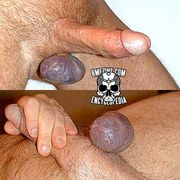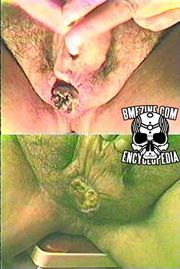Dry Gangrene


Dry gangrene, more commonly known as mummification, is a kind of gangrene that develops when tissue is deprived of circulation for extended periods. The tissue dries out and shrivels, is usually a bit greasy to the touch, and turns a dark brown or black with a clear line between the healthy and necrotic tissue. Infection is surprisingly rare: eventually the dead tissue literally just falls off, unlike other forms of gangrene which often cause life-threatening infections.
Dry gangrene can happen naturally when circulation is compromised (such as from diabetes), or from intentional damage or destruction of the arteries supplying the tissue. It can occur either slowly, as with diabetes, atherosclerosis, leprosy, etc., more quickly as with elastration castration tools and the burdizzo, or accidentally as a result of frostbite or other similar conditions.
Once induced, dry gangrene will feel like a dull ache, which may escalate to almost unbearable levels of discomfort over the first 6-12 hours. After about a day has passed that feeling is basically gone (many people elect to cut off the dead tissue at this point—however, any artificial method of constriction must be left on, or the wound is likely to burst open). It is important to note that even with dry gangrene, although rare, it is possible for sepsis (blood poisoning) to set in, which is extremely serious and can potentially lead to death.
It should be noted that in the veterinary world, castration employing dry gangrene (using elastrator tools and burdizzos) is a normal and time-tested method that is considered by many to be safer than invasive surgical methods. In the body modification community, this method is almost exclusively used for male castration, but in theory it could also work on fingers — though this is not recommended.
